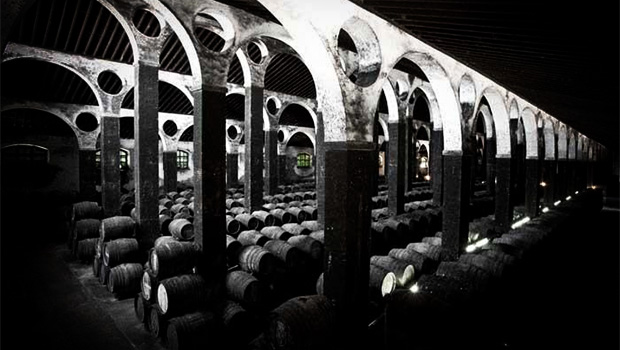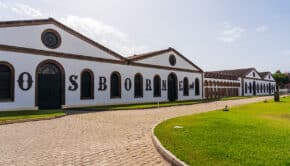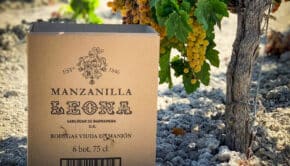The architecture of bodegas in Jerez
The sherry region may not have attracted iconic modern architects (so far) like in Rioja, but their old bodegas are certainly not less beautiful and impressive. They’re highly functional buildings which combine efficiency and beauty – the result of a long and successful optimization process.
Over the course of many centuries, bodegas in the Jerez area evolved and developed some unique characteristics. Bodegas are not just a shelter for precious barrels, they are a tool to shape the wines and help them develop in the right way, just as important as the grapes, the soil, the climate or the people working inside them. The architecture of a bodega often imparts a specific character to the wines, a unique fingerprint, and can be seen as an key element in the terroir of Jerez.
Favouring flor through architecture
The first bodegas (17th-18th century) were small and low, often converted graineries or other warehouses, some built upon Moorish structures. They predate the concept of biological ageing under flor and the solera system. Good examples are the Bodega del Toro (Barbadillo) or the oldest part of Fernando de Castilla in the Calle Jardinillo.
In the late 18th century this started to change, with bodegas different types and sizes, always a compromise of form and function, ideal conditions and practicality. To understand the characteristics of the classic sherry bodega we can have a look at what Boutelou wrote in 1807:
The bodegas of the winegrowers of Xerez and Sanlúcar are highly spacious, ventilated, divided into aisles and sustained by high arches of masonry. The wine is not stored in cellars or underground caves but it is grown and aged inside the bodegas built at ground level. Some of them have a capacity for two, three and four thousand barrels of wine; the house of the Hauries owns by far the biggest bodega as one of its aisles is 95 yards (varas) long by 42 yards wide each and they had six lines or twelve rows of barrels.
Cathedral-style bodegas
The archetype of bodega architecture described by Boutelou is called the cathedral-style bodega, which is very large, has a double sloping roof and several longitudinal aisles divided by arches and thin pillars which support the high ceiling.
Two of the best examples of this style are found in La Arboledilla (lead picture and 3D visit below, built for Bodegas Manjón in 1876, now owned by Bodegas Barbadillo) and La Mezquita (Bodegas Domecq, built 1971-1974).
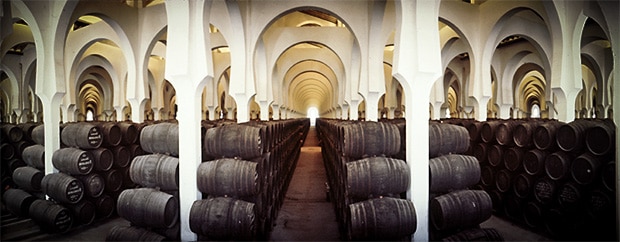
Bodega La Mezquita – Pedro Domecq
Essential environmental conditions
The cathedral-type bodega appears at the beginning of the nineteenth century at a time when wine production and exports were undergoing a remarkable expansion. Characteristics like the maturation under flor and the solera system became widespread (around 1750-1780) and soon after there was the Golden Age of sherry (1820-1880) which led to the foundation of numerous new bodegas and the development of the Fino style as we know it today.
The flor in Fino and Manzanilla brings along specific challenges and requirements from a production point of view. The Saccharomyces yeasts are living organisms that require specific conditions:
- Moderate and stable temperatures: in a region like Andalucia, with such cruel summers, it can be hard to maintain constant temperatures. Flor thrives around 18°C so this may seem quite a challenge with outside temperatures of up to 40°C.
- Plenty of fresh air, as flor needs oxygen to survive. To give you an idea, the bodega La Mezquita contains 40.000 barrels, but even then the amount of free air comes down to 18-19 m³ per cask. This is the main reason for not using cellars.
- High levels of humidity (preferably over 70%) are necessary to keep the flor active, but also to minimize the merma, the evaporation of alcohol inside the barrels.
It is therefore no surprise that the cathedral-style bodegas of the late 19th century are built specifically to foster a favourable environment for flor, adapted to the solera system and focused on shipping large quantities of wine. Of course oxidatively aged wines like Oloroso also mature well in constant, humid environments. Bodegas look for the coolest, most humid places (close to the floor) within each building and locate the biologically aged wines there, whereas oxidatively aged wines take up warmer locations.

Bodega Los Arcos – Lustau (built in 1862)
Architectural characteristics of bodegas in Jerez
So, which specific architectural characteristics are so unique for bodegas in Jerez, and how do these elements relate to the production of the wines?
High ceilings
High ceilings are a key element in keeping temperatures low: on the one hand the huge volume of air takes longer to warm (acting as an insulating chamber), on the other hand the height lets the hot air rise well above the barrels. The central arch of bodegas in Jerez can reach up to 15 metres, with slightly lower side arches. It is reckoned that the total volume of air inside a bodega should be around 18-20 times that of the wines.
As hot air rises, it keeps the ground level cooler, which is why Fino and Manzanilla casks are usually located near the floor and oxidative types of sherry towards the top of the solera stacks.
The high roofs are usually supported by an A-frame or other open structures that don’t block the airflow. Often the roofs wille be made with curved Arab tiles for insulation, and sometimes there is a cork lining to keep more heat out.
Small windows
When the hot air rises, it is evacuated through small, high-placed windows which act as chimneys. They are usually rectangular or square, although some are circular to stress the resemblance with churches. During the day they are covered with esparto grass blinds, to block most of the light but also to keep dust and insects out, but they’re never fully closed of course. By keeping the esparto grass moist, the air that goes in is cooled down.
Thick walls
Thick walls – 60 centimetres or more, with no insulation – are another key element: their inertia keeps the temperatures stable day and night. Building them in a porous material helps to transmit moisture and produce high levels of humidity on the inside.
Walls are painted white on the outside, to block sunlight.
Albero floors
Floors inside bodegas are usually made of albero, a rough sandy clay or gravel that you also find in bullrings. They are sprinkled with water two to three times a week during the summers, which makes the water evaporate to keep the humidity high while also tempering the heat. Arabic tiles or earthen floors also work well in this respect, and can be seen in a few bodegas.
Orientation
Bodegas want to bring in the westerly winds (poniente) that come from the Atlantic ocean (bringing cool, humid air) and at the same time block most of the dry, hot levante winds blowing in from the east over land. Therefore, bodegas are built in strategic locations, with carefully chosen altitude and orientation, for instance on the edge of the high area of Sanlúcar where they are more open to wind without being blocked by surrounding buildings. At the same time their smallest surface will be oriented towards the south, to minimize exposure during the hottest hours. A north-east to south-west axis is perfect for minimum exposure to the sun and maximum exposure to winds.
Visit a bodega in Jerez
Looking at these cathedral-style bodegas, you’ll notice an interesting duality of grandeur and impressive size, opposed to a certain minimalism and soberness that comes from the repetition, the dark atmosphere and functional origins. Bodegas are biological ecosystems, always balancing the natural environment in order to have the perfect conditions for the development of the wine. The specific nature of sherry wines caused bodegas to develop a unique style of buildings.
Have you visited bodegas in Jerez? Be sure to check out the Sherry Wine and Brandy Route to discover some unique wineries. Feel free to comment with your favourite building!
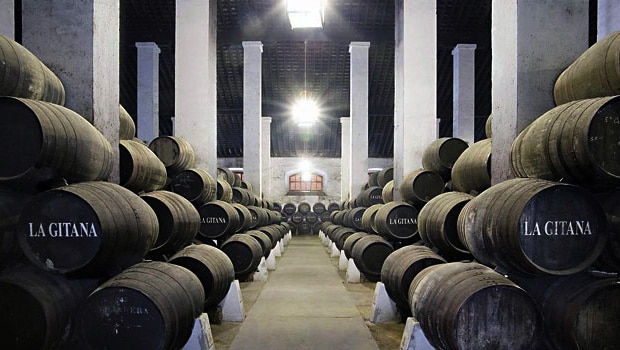
Bodegas Hidalgo – La Gitana
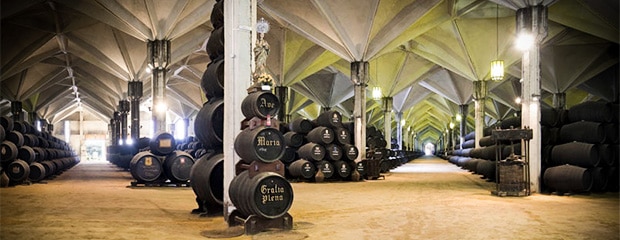
Williams & Humbert, the largest winery premise in Europe
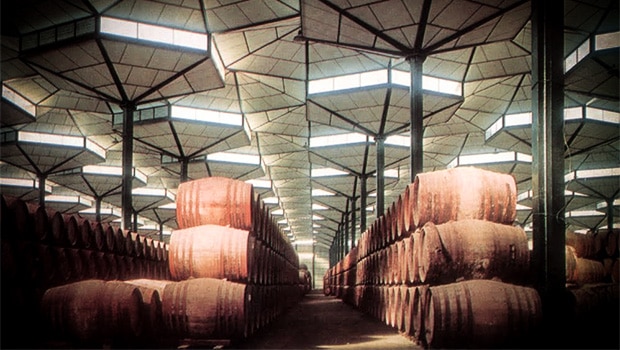
Bodega Las Copas, mainly used for the maturation of brandy by González Byass & Emperador


